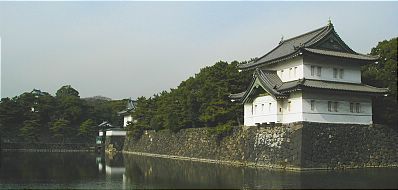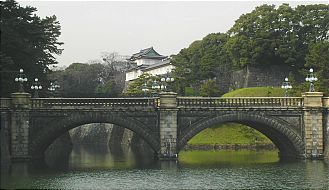Tokyo Day 1
It took me about 2 hours to navigate from Narita Airport to my hotel in Tokyo. I took a train from Narita to Ueno Station which was just one short stop from my Hotel at Mashimusha Hostel. Upon arriving I met my roommates who where from the Czech Republic they had just arrived that same day and all but one was asleep. They where extremely friendly and we agreed to go out sometime. The first day I slept in to make up for the 15 hour time difference! It hasn't been too hard adjusting thus far. The fourth day is usually when it hits me the most! I ventured out of the room around 10 AM and made my way to the Imperial Palace. This is a castle area with a moat and everything! Its not as large as what it use to because of air raids during War World II. It currently only houses only the emperor and emperoress whose last child just moved out a year ago due to marriage. The Palace is half the size of Central Park.
he current Imperial Palace (Kokyo) is located on the former site of Edo Castle, a large park area surrounded by moats and massive stone walls in the center of Tokyo, a short walk from Tokyo station. It is the residence of Japan's Imperial Family.

Edo Castle used to be the seat of the Tokugawa shogun who ruled Japan from 1603 until 1867. In 1868, the shogunate was overthrown, and the country's capital and Imperial Residence were moved from Kyoto to Tokyo. In 1888 construction of a new Imperial Palace was completed. The palace was once destroyed during World War Two, and rebuilt in the same style, afterwards.
From Koyo Gaien, the large plaza in front of the Imperial Palace, visitors can view the Nijubashi, two bridges that form an entrance to the inner palace grounds. The stone bridge in front is called Meganebashi (Eyeglass Bridge) for its looks. The bridge in the back was formerly a wooden bridge with two levels, from which the name Nijubashi (Double Bridge) is derived.

The palace buildings and inner gardens are not open to the public. Only on January 2 (New Year's Greeting) and December 23 (Emperor's Birthday), visitors are able to enter the inner palace grounds and see the members of the Imperial Family, who make several public appearances on a balcony.
During the rest of the year, guided tours of the palace are offered in Japanese, with an English pamphlet and audio guide provided. Tours must be reserved in advance at the Imperial Household Agency. Reservations over the internet are possible (see links below).
The Imperial Palace East Gardens are open to the public throughout the year except on Mondays, Fridays and special occasions. Please visit the East Gardens information page for more information.
Following the palace I went to a nearby visitors center to get information on tours and other activities in the area. I booked a seat on the Grey Line Tour for the next day.
I then made my way to the Yasukuni Shrine. The Shrine houses the cremated ashes of all those who have died in war. This shrine is a controversial topic to China due to the housing of War Criminals from the Sino(China)-Japanese War. This topic has been in the news quiet often in the past year. There is also a war museum at the same location that displays many cannons, Ship Replicas, War Planes, and tells the history of many wars, including Pearl Harbor. It was interesting to see Pearl Harbor Celebrated? What was strange was the actual differences in the history as portrayed by each country. The Atomic Bombs that where dropped on Japan where only mentioned in one short sentence. It also failed to mention that there where actual War Criminals involved on behalf of Japan, but that is just Country biases. I was quite perplexed by this!
I then went to the Shinjuku area of Tokyo. This area was the most bustling area of the city that i had been to so afar. This area houses the Metropolitan Government Center, a beautiful twin tower building.
Tokyo Metropolitan Government Office (Tocho)
The 243 meter tall twin towers and surrounding buildings contain the offices and the assembly hall of the metropolitan government of Tokyo, as well as observatories on the 45th floor of each tower.
Kabukicho
Named after a kabuki theater, whose construction plans have never been realized, Japan's largest red light district features countless restaurants, bars, pachinko parlors, love hotels and a wide variety of red light establishments for both sexes and sexual orientations. I so didn't realize that this area was the red light district until I was propositioned several times! LOL. I went on my way and got back into the mainstream area.
Takashimaya Tokyo Times Square
Opened in 1996, the Shinjuku branch of Takashimaya consists of 15 floors, including a food department in the basement and three restaurant floors. A Tokyo Hands branch and Kinokuniya book store with a large foreign language section are located in the same building complex, also known as "Times Square". This area had many neon lights and large TV Scrense on the sides of the building. It was really amazing to see how the city glowed at night.
Some Unusual Things about Tokyo
1) How quiet it is around the city? You would think with a city of 12 Million people that it would feel like the hussle and bussle of the big city. It is quiet eerie!
2) pacing a form of gambling throughout the city. It is similar to a slot machines but involves maneuvering balls in a machine.
3) Organization of the city. Land restrictions have made the city seem a little organized
4) I have only seen about 2 pieces of trash on the streets!
5) The Japanese seem toned into there own business and rarely make eye contact.
It was an extremely long day of Walking throughout the the city. I climbed numerous stairs throughout the metro stations and other areas. My cavs where killing me since I haven't been doing much walking since Graduation. I went back to the hotel and quickly crashed because i had to get up early to catch the next days tour!

0 Comments:
Post a Comment
<< Home